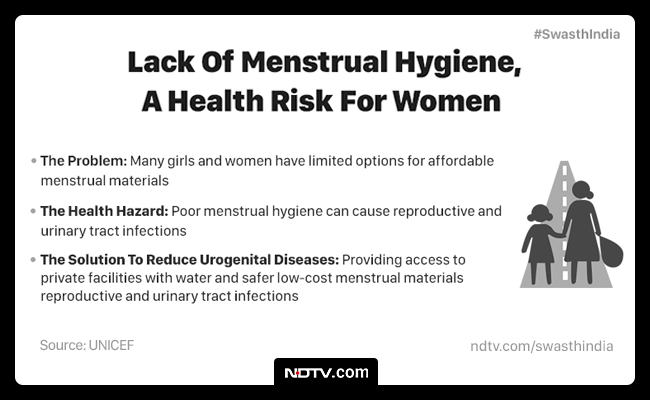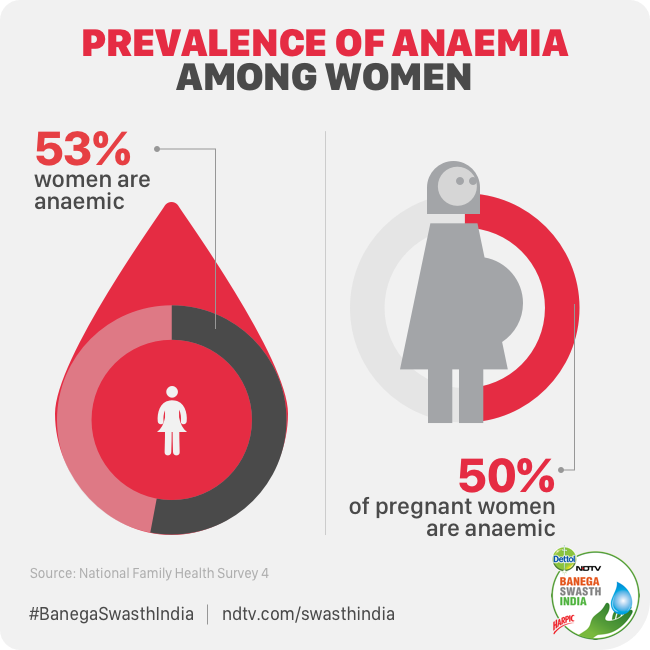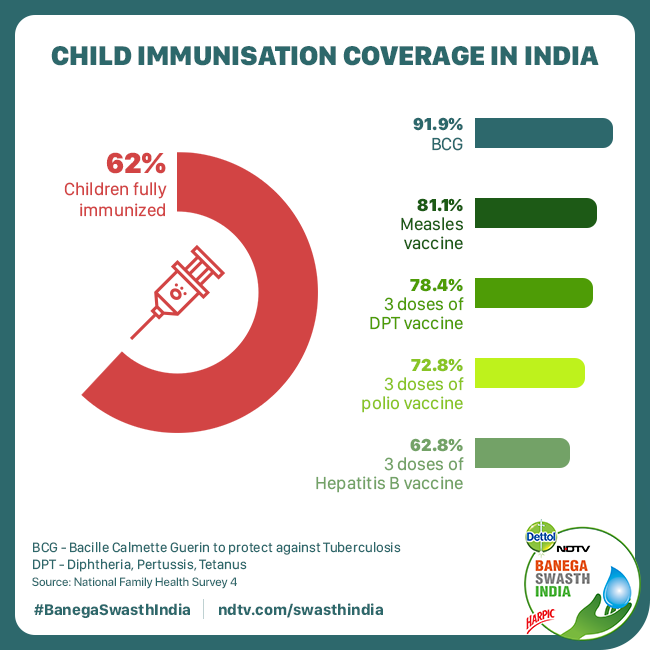New Delhi: International Women’s Day is the focal point in the movement for women’s rights. The day marks the struggle being fought all over the world for gender equality in every walk of life. Even today women are denied access to some of life’s basic needs like nutritious diet, sanitation and health facilities. This Women’s Day, we draw attention to some of the serious health issues that women in India are grappling with that need attention and concentrated effort from all stakeholders to tackle.
Menstrual Hygiene
Menstruation continues to be a taboo topic in India with many considering periods to be ‘dirty’ and ‘impure’ hence women are prohibited from going to religious places or even preparing food in some cases during their menstrual cycle.
It is such a taboo topic that it has been found in a study by Indian Council for Medical Research’s 2011-12 report, that only 38 per cent menstruating girls in India spoke to their mothers about menstruation. Many mothers were themselves unaware what menstruation was, how it was to be explained to a teenager and what practices could be considered as menstrual hygiene management. Schools were not very helpful either as schools in rural areas refrained from discussing menstrual hygiene.
A 2015 survey by the Ministry of Education found that in 63 per cent schools in villages, teachers never discussed menstruation and how to deal with it in a hygienic manner, making it even more difficult for young girls and women to break out of the vicious cycle of misconceptions.
National Family Health Survey 2015-2016 estimates that of the 336 million menstruating women in India only 121 million (roughly 36 percent) women are using sanitary napkins, locally or commercially produced.
It’s disappointing that nearly 70 per cent of the menstruating women in India don’t have access to hygienic and menstrual care products. This is not only due to the stigma but also due to lack of awareness and economic reasons, where sanitary pad is still unaffordable for many. Most women are still resorting to unhygienic methods like using cloths, rags, leaves or husks. This can result in infections, rashes, and discomfort among other deadly complications.
Roughly 120 million menstruating adolescents in India experience menstrual dysfunctions, affecting their normal daily chores. Nearly 60,000 cases of cervical cancer deaths are reported every year from India, two-third of which are due to poor menstrual hygiene. Other health problems associated with lack of menstrual hygiene are anaemia, prolonged or short periods, infections of reproductive tracts, as well as psychological problems such as anxiety, embarrassment and shame.

National Family Health Survey 2015-2016 estimates that of the 336 million menstruating women in India only 36 percent are using sanitary napkins
Also Read: International Women’s Day Special: Why Is Nutrition Important For Women’s Health, Experts
Anaemia
Anaemia is a blood disorder in which the oxygen-carrying capacity is reduced due to low levels of haemoglobin (Hb) in the blood or low production of healthy red-blood cells (RBCs). The disorder makes people fatigued and experience loss of energy because of the lack of oxygen in the body. It is caused due to inadequate nutrition and deficiency of vital elements like Iron and Vitamin B12. As per experts, Iron deficiency caused anaemia is the most common form of the disease.
According to the National Family Health Survey 4 which was conducted across the country in 2015-16, in India nearly 60 per cent of the children under five years and 53 per cent women in the childbearing age have Anaemia, which is the highest in the world.
NFHS 4, further states that there has been a slight decline in Anaemia among pregnant women from 57.9 per cent in NFHS 3 (2005-06) to 50.4 per cent in NFHS 4 (2015-16). Despite this drop, Anaemia is still more prevalent among women (pregnant and non-pregnant) belonging to the age group of 15-49 years when compared to men of the same age group (22.7).
Clinical Nutritionist Lovneet Batra says that the need for iron increases by more than 70 per cent in pregnant women. She also highlighted that women, especially in the child-bearing age group are more likely to suffer from anaemia due to heavy blood flow during menstruation or during delivery when the blood loss is high.
She asserted that while in normal conditions, 21 milligram of iron is required, the iron need of a pregnant woman increases by more than 70 per cent and if this is not met, she may become anaemic which can have negative impact on the development of the foetus. The risk due to anaemia in pregnant women include pre-term labour and giving birth to a low weight child.
Even though anaemia is most prevalent among women, most of them are not even aware that they are suffering from anaemia. Anaemia comes in many forms and sometimes it may even go undiagnosed when the symptoms are not prominent. Like the person may feel fatigued or dizzy but that can be a symptom from so many other kinds of illness and disorders as well.
Various efforts are being made by the central and local governments to tackle the widely prevalent condition like celebrating a month-long nutrition campaign to combat anaemia, by distributing supplements to mitigate the iron and other deficiencies among poor people. There is still a long way to go when it comes to eradicating Anaemia from the country.

According to the National Family Health Survey 4 nearly 60 per cent of the children under five years and 53 per cent women in the childbearing age in India have Anaemia, which is the highest in the world
Government launched the programme Anaemia Mukt Bharat, which is an intensified Iron-plus Initiative that aims to strengthen the existing programmes to tackle the issue.
Anaemia Mukt Bharat focusses on six target beneficiary groups, through six interventions and six institutional mechanisms to achieve the envisaged target under the POSHAN Abhiyan. The programme is estimated to reach out to 450 million beneficiaries with specific anemia prevalence targets for year 2022 to be achieved among various population groups.
Also Read: Access To Toilets And Role Of Women, A Case Study Of Chakkarpur Slum In Open Defecation Free Haryana
Lack Of Immunisation
Immunisations and vaccinations are the most effective ways to prevent the harmful short and long term effects of serious yet preventable diseases.
Their importance cannot be stressed enough, says Dr. Shroff from Gynaecology Department at All India Institute of Medical Sciences.
According to UNICEF, India has 7.4 million children who are not immunised which is the largest number in the world.
Unfortunately, gender also plays a role in whether children are immunised or not, with girls reportedly receiving fewer vaccines than boys. In a lot of villages and small towns, girls often don’t get vaccinated because of a simple reason – they’re girls, Dr. Shroff explains.
According to UNICEF, India still lacks a robust system to track vaccine-preventable diseases. Vaccination coverage varies considerably from state to state, with the lowest rates in India’s large central states. Differences in uptake are geographical, regional, rural-urban, poor-rich and gender-related. On average, girls receive fewer immunizations than boys and higher birth order infants have lower vaccination coverage, states UNICEF.
According to NFHS 4, at 88.4 per cent, Goa has the highest full immunisation coverage among states, while Nagaland has the lowest at 35.7 per cent. The Health Survey of Population Census of India reports that in some places like Malkangiri district in Odisha the immunisation coverage is as low as 29.6 per cent. While talking to NDTV about the poor immunisation coverage in India, Dr. Anil Kumar Aggarwal, Health Specialist, UNICEF Rajasthan said,
There is still a long way to go for achieving universal coverage in terms of full immunisation in India but the available evidences like eradication of polio and reduction in measles, clearly suggest that the investment made in preventive and primitive care yields multi-fold returns on investment, as it not only reduces mortality and morbidity but also leads to healthy life of citizens.

According to UNICEF, India has 7.4 million children who are not immunised which is the largest number in the world
Malnutrition
According to a joint study conducted by ASSOCHAM and EY, India is home to one of the most number of malnourished children in the world. As per UNICEF, 69 per cent children under the age of five in India die due to malnutrition. India also remains among the countries with the highest rates of malnourished females in the developing world. This is especially serious in locations where gender as well as economic inequality is widespread, leaving underprivileged citizens unable to provide three nutritious meals for themselves and their family.
According to NFHS 4, India saw a reduction of about 9.6 percent in the cases of stunting (low height for age) of children under five. About 38.4 per cent children under the age of five in India were stunted in 2015-2016 as compared to 48 per cent in 2005-2006. The country also witnessed a 6.7 per cent decrease in the cases of underweight children. 35.8 per cent children among those in the age groupof 5 were underweight in 2015-2016, down from 42.5 per cent in 2005-2006. When it comes to the cases of wasting (low weight for height), India witnessed a rise of 1.2 percent, with 21 per cent wasted children under the age of five in 2015-2016, compared to 19.8 in 2005-2006.
Malnutrition can make individuals, especially young girls and boys more vulnerable to contagious diseases such as pneumonia and tuberculosis and lead to fatal consequences. Nutrition also has an important role to play in maintaining maternal health and the health of babies, Dr. Shroff explains.

According to a joint study conducted by ASSOCHAM and EY, India is home to one of the most number of malnourished children in the world
Maternal Healthcare
Maternal mortality remains a major issue across the country due to poverty, superstitions, regressive mentality and the lack of access to proper medical care, Dr. Shroff told NDTV.
Globally, about 800 women die every day of preventable causes related to pregnancy and childbirth; 20 per cent of these women are from India, reports UNICEF. Poor socioeconomic conditions in India limit access to adequate maternal health care for a large number of women. Mothers in the lowest economic bracket have about a two and a half times higher mortality rate, according UNICEF.
This also impacts their children’s health as well as the mother’s abilities to lead a healthy life. The current maternal mortality rate in India stands at 122 deaths per 1000 live births according to the special bulletin of the Office of the Registrar General in 2015-17. The figure is a minor improvement of 6.15 per cent reduction since the last survey figures of 2014-2016, but we still have a long way to go.
As per UNICEF, the improvement is largely due to key government interventions such as the Janani Suraksha Karyakaram (JSSK) scheme which encompasses free maternity services for women and children, a nationwide scale-up of emergency Shishu Referral systems and maternal death audits, and improvements in the governance and management of health services at all levels.
However, adolescent and illiterate mothers and those living in hard to reach areas still have a much greater chance of dying in childbirth. Adolescent girls outside Indian cities are especially vulnerable as teenage marriage and pregnancies are very high in rural and remote areas of the country.
Anganwadi and ASHA workers across the nation have taken the lead to go to each household and explain to them the importance of maternal healthcare. The schemes like Janani Shishu Suraksha Karyakaram, are depended upon the network of these women, who are the foot soldiers of India’s healthcare system, by reaching the most remotely located women. The number of women who work as Anganwadi workers in India is close to 25 lakhs while there are close to 10 lakh ASHA workers in the country. And they hold the key to ensure India and Indian women in particular become Swasth.






























